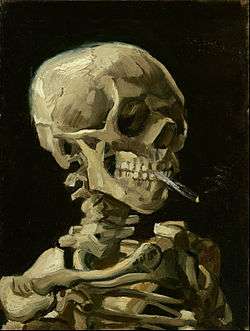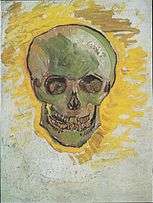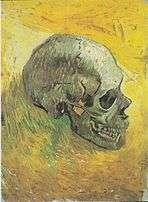Skull of a Skeleton with Burning Cigarette
| Dutch: Kop van een skelet met brandende sigaret | |
 | |
| Artist | Vincent van Gogh |
|---|---|
| Year | c. 1885–86 |
| Catalogue | F212 |
| Medium | Oil on canvas |
| Dimensions | 32 cm × 24.5 cm (13 in × 9.6 in) |
| Location | Van Gogh Museum, Amsterdam |
| 52°21′31″N 4°52′53″E / 52.35854°N 4.881319°ECoordinates: 52°21′31″N 4°52′53″E / 52.35854°N 4.881319°E | |
Skull of a Skeleton with Burning Cigarette (Dutch: Kop van een skelet met brandende sigaret) is an early work by Vincent van Gogh. The small and undated oil-on-canvas painting featuring a skeleton and cigarette is part of the permanent collection of the Van Gogh Museum in Amsterdam.[1] It was probably painted in the winter of 1885–86 as a humorous comment on conservative academic practices[1] – before painting live human models, the academic routine would have included studies of skeletons, to develop an understanding of human anatomy - an assumption based on the fact that Van Gogh was in Antwerp at that time, attending classes at the Royal Academy of Fine Arts, classes he would later say were boring and taught him nothing.[2]
Van Gogh included skeletons in another work from his Antwerp period, a sketch of a "Hanging skeleton and cat". In 1887–88, van Gogh painted two more paintings with skulls, the only other works of his (besides a drawing from the same period) to use skulls as a motif.[2]
The work measures 32 by 24.5 centimetres (12.6 in × 9.6 in). It is considered a vanitas or memento mori, at a time when Van Gogh himself in poor health. It may be influenced by works of Hercules Segers, a 17th-century Dutch artist, or of Félicien Rops, a Belgian contemporary of Van Gogh. Although often interpreted as a criticism of smoking, Van Gogh was a keen smoker himself, and continued to smoke until his death in 1890.[2]
In 2008, the painting was used by graphic designer Chip Kidd on the first edition cover for When You Are Engulfed in Flames, a collection of essays written by David Sedaris. Sedaris is said to have been "fascinated with the image" after seeing it on a postcard during a trip to Amsterdam.[2]
The painting was held by Van Gogh's brother Theo Van Gogh at the time of his death in 1891. It was inherited by his widow Johanna van Gogh-Bonger until her death in 1925, and then by their son Vincent Willem van Gogh until 1962, when it was acquired by the Van Gogh Foundation. It was on loan to the Stedelijk Museum from 1962 to 1973, and has been on permanent loan to the Van Gogh Museum in Amsterdam since 1973.[3]


References
- 1 2 "Skull of a Skeleton with Burning Cigarette, 1886". Van Gogh Museum. Retrieved 2013-05-19.
This curious and somewhat macabre little painting is undated. It was probably executed in the winter of 1885–86, during Van Gogh’s stay in Antwerp....This skull with a cigarette was likely meant as a kind of joke, and probably also as a comment on conservative academic practice.
Archived February 3, 2012, at the Wayback Machine. - 1 2 3 4 Bundrick, Sheramy (June 14, 2008). "Memento Mori or Just a Joke?". Van Gogh's Chair (blog). blogspot.com. Retrieved 2013-05-19.
[H]is letters and anecdotes from others record that he sparred with his drawing and painting teachers and was scornful of conservative academic practice. His time at the Academy lasted only weeks; he felt he was learning nothing and later proclaimed academic training "damned boring". Taken from that perspective, 'Skull of a Skeleton with Burning Cigarette' could be read as a thumbing-of-the-nose at 'the establishment.'
- ↑ Skull with Burning Cigarette, vggallery.com
External links
-
 Media related to Skull with a burning cigarette by Vincent Van Gogh at Wikimedia Commons
Media related to Skull with a burning cigarette by Vincent Van Gogh at Wikimedia Commons